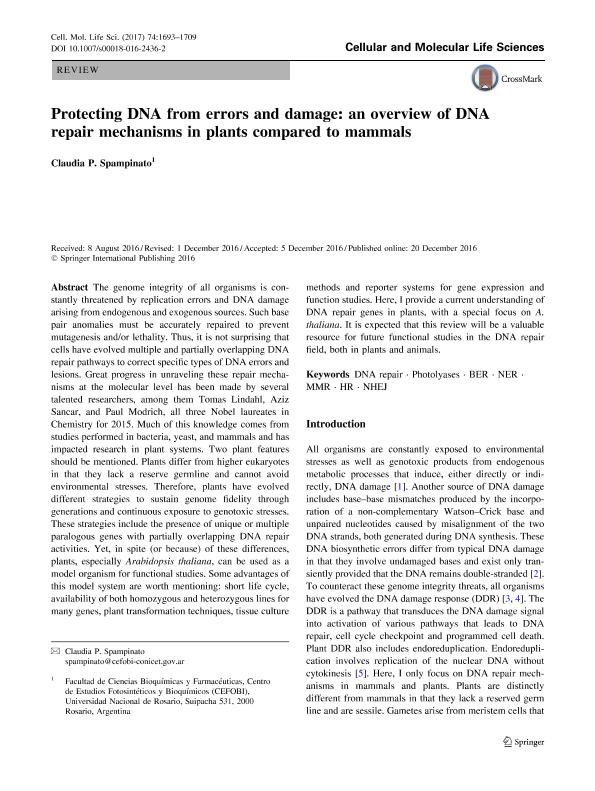Mostrar el registro sencillo del ítem
dc.contributor.author
Spampinato, Claudia Patricia

dc.date.available
2018-07-27T13:51:30Z
dc.date.issued
2017-05
dc.identifier.citation
Spampinato, Claudia Patricia; Protecting DNA from errors and damage: an overview of DNA repair mechanisms in plants compared to mammals; Birkhauser Verlag Ag; Cellular and Molecular Life Sciences; 74; 9; 5-2017; 1693-1709
dc.identifier.issn
1420-682X
dc.identifier.uri
http://hdl.handle.net/11336/53283
dc.description.abstract
The genome integrity of all organisms is constantly threatened by replication errors and DNA damage arising from endogenous and exogenous sources. Such base pair anomalies must be accurately repaired to prevent mutagenesis and/or lethality. Thus, it is not surprising that cells have evolved multiple and partially overlapping DNA repair pathways to correct specific types of DNA errors and lesions. Great progress in unraveling these repair mechanisms at the molecular level has been made by several talented researchers, among them Tomas Lindahl, Aziz Sancar, and Paul Modrich, all three Nobel laureates in Chemistry for 2015. Much of this knowledge comes from studies performed in bacteria, yeast, and mammals and has impacted research in plant systems. Two plant features should be mentioned. Plants differ from higher eukaryotes in that they lack a reserve germline and cannot avoid environmental stresses. Therefore, plants have evolved different strategies to sustain genome fidelity through generations and continuous exposure to genotoxic stresses. These strategies include the presence of unique or multiple paralogous genes with partially overlapping DNA repair activities. Yet, in spite (or because) of these differences, plants, especially Arabidopsis thaliana, can be used as a model organism for functional studies. Some advantages of this model system are worth mentioning: short life cycle, availability of both homozygous and heterozygous lines for many genes, plant transformation techniques, tissue culture methods and reporter systems for gene expression and function studies. Here, I provide a current understanding of DNA repair genes in plants, with a special focus on A. thaliana. It is expected that this review will be a valuable resource for future functional studies in the DNA repair field, both in plants and animals.
dc.format
application/pdf
dc.language.iso
eng
dc.publisher
Birkhauser Verlag Ag

dc.rights
info:eu-repo/semantics/openAccess
dc.rights.uri
https://creativecommons.org/licenses/by-nc-sa/2.5/ar/
dc.subject
Ber
dc.subject
Dna Repair
dc.subject
Hr
dc.subject
Mmr
dc.subject
Ner
dc.subject
Nhej
dc.subject
Photolyases
dc.subject.classification
Otras Ciencias Biológicas

dc.subject.classification
Ciencias Biológicas

dc.subject.classification
CIENCIAS NATURALES Y EXACTAS

dc.title
Protecting DNA from errors and damage: an overview of DNA repair mechanisms in plants compared to mammals
dc.type
info:eu-repo/semantics/article
dc.type
info:ar-repo/semantics/artículo
dc.type
info:eu-repo/semantics/publishedVersion
dc.date.updated
2018-07-26T14:00:44Z
dc.journal.volume
74
dc.journal.number
9
dc.journal.pagination
1693-1709
dc.journal.pais
Suiza

dc.journal.ciudad
Basel
dc.description.fil
Fil: Spampinato, Claudia Patricia. Consejo Nacional de Investigaciones Científicas y Técnicas. Centro Científico Tecnológico Conicet - Rosario. Centro de Estudios Fotosintéticos y Bioquímicos. Universidad Nacional de Rosario. Facultad de Ciencias Bioquímicas y Farmacéuticas. Centro de Estudios Fotosintéticos y Bioquímicos; Argentina
dc.journal.title
Cellular and Molecular Life Sciences

dc.relation.alternativeid
info:eu-repo/semantics/altIdentifier/doi/https://dx.doi.org/10.1007/s00018-016-2436-2
dc.relation.alternativeid
info:eu-repo/semantics/altIdentifier/url/https://link.springer.com/article/10.1007%2Fs00018-016-2436-2
Archivos asociados
